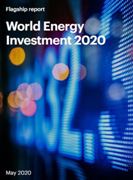Impacts are felt across the energy world, from fuel and power supply to efficiency, with serious implications for energy security and clean energy transitions, says a new report released by the International Energy Agency (IEA).
The Covid-19 pandemic has set in motion the largest drop in global energy investment in history, with spending expected to plunge in every major sector this year – from fossil fuels to renewables and efficiency – the International Energy Agency said in a new report released today.
Global investment in oil and gas is expected to fall by almost one-third in 2020. The shale industry was already under pressure, and investor confidence and access to capital has now dried up: investment in shale is anticipated to fall by 50% in 2020. At the same time, many national oil companies are now desperately short of funding. For oil markets, if investment stays at 2020 levels then this would reduce the previously-expected level of supply in 2025 by almost 9 million barrels a day, creating a clear risk of tighter markets if demand starts to move back towards its pre-crisis trajectory.
Power sector spending is on course to decrease by 10% in 2020, with worrying signals for the development of more secure and sustainable power systems. Renewables investment has been more resilient during the crisis than fossil fuels, but spending on rooftop solar installations by households and businesses has been strongly affected and final investment decisions in the first quarter of 2020 for new utility-scale wind and solar projects fell back to the levels of three years ago. An expected 9% decline in investment in electricity networks this year compounds a large fall in 2019, and spending on important sources of power system flexibility has also stalled, with investment in natural gas plants stagnating and spending on battery storage levelling off.
“Electricity grids have been a vital underpinning of the emergency response to the health crisis – and of economic and social activities that have been able to continue under lockdown,” Dr Birol said. “These networks have to be resilient and smart to ward against future shocks but also to accommodate rising shares of wind and solar power. Today’s investment trends are clear warning signs for future electricity security.”
Energy efficiency, another central pillar of clean energy transitions, is suffering too. Estimated investment in efficiency and end-use applications is set to fall by an estimated 10-15% as vehicle sales and construction activity weaken and spending on more efficient appliances and equipment is dialed back.
The overall share of global energy spending that goes to clean energy technologies – including renewables, efficiency, nuclear and carbon capture, utilization and storage – has been stuck at around one-third in recent years. In 2020, it will jump towards 40%, but only because fossil fuels are taking such a heavy hit. In absolute terms, it remains far below the levels that would be required to accelerate energy transitions.
“The crisis has brought lower emissions but for all the wrong reasons. If we are to achieve a lasting reduction in global emissions, then we will need to see a rapid increase in clean energy investment,” said Dr Birol. “The response of policy makers – and the extent to which energy and sustainability concerns are integrated into their recovery strategies – will be critical. The IEA’s upcoming World Energy Outlook Special Report on Sustainable Recovery will provide clear recommendations for how governments can quickly create jobs and spur economic activity by building cleaner and more resilient energy systems that will benefit their countries for decades to come.”
The Covid-19 crisis is hurting the coal industry – with investment in coal supply set to fall by one-quarter this year – but does not pose an existential threat. Although decisions to go ahead with new coal-fired plants have come down by more than 80% since 2015, the global coal fleet continues to grow. Based on available data and announced projects, approvals of new coal plants in the first quarter of 2020, mainly in China, were running at twice the rate observed over 2019 as a whole.

